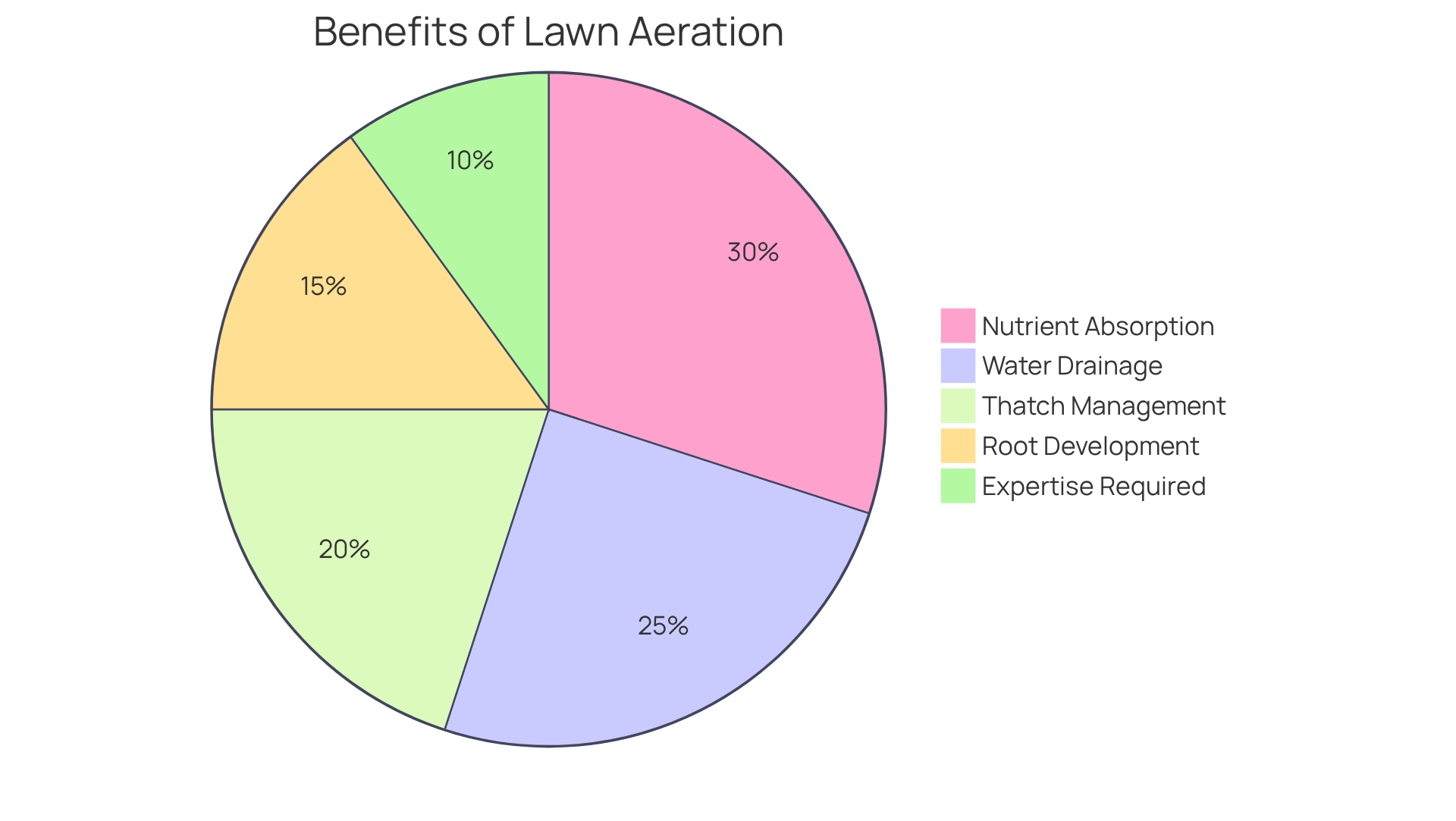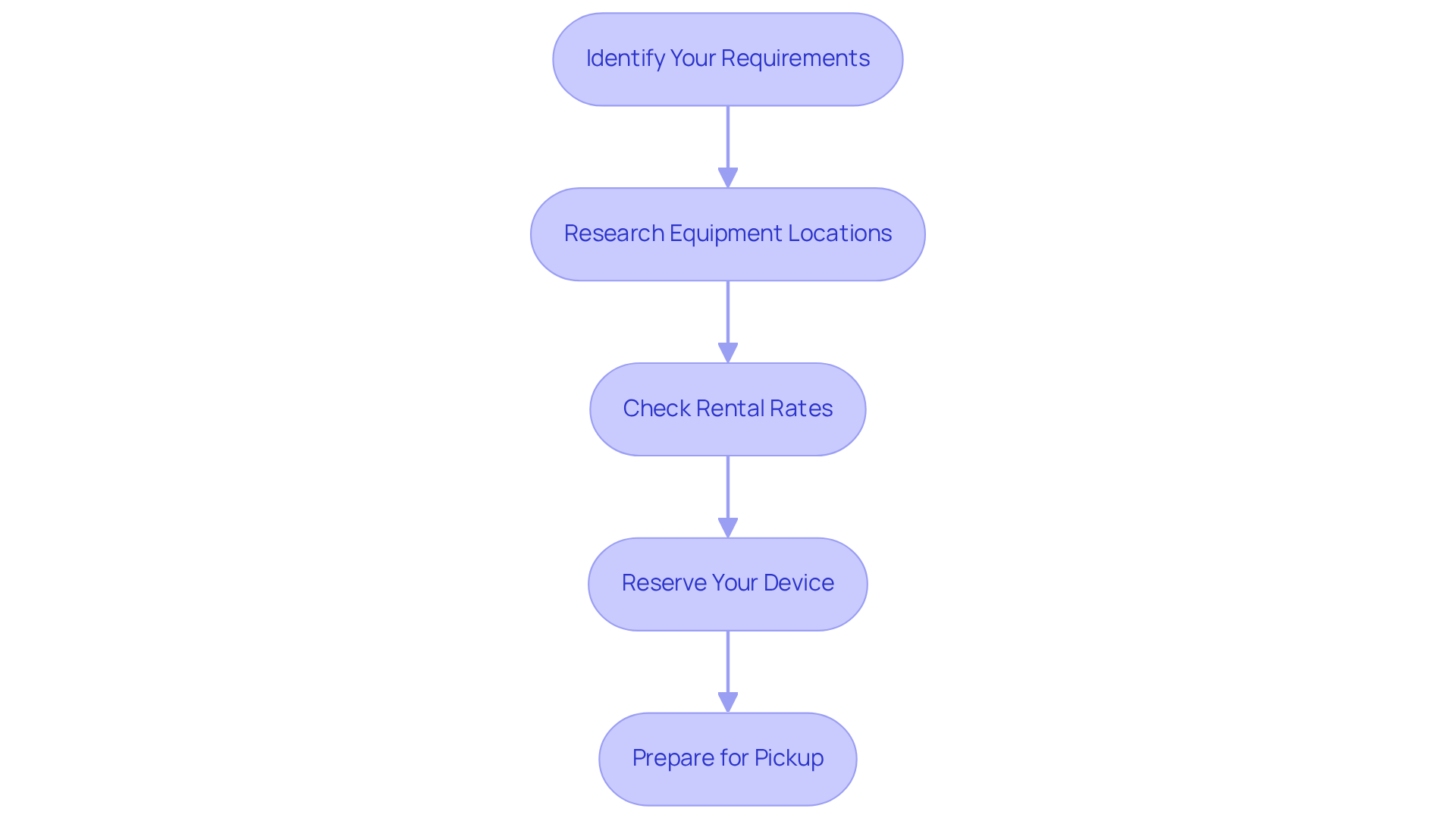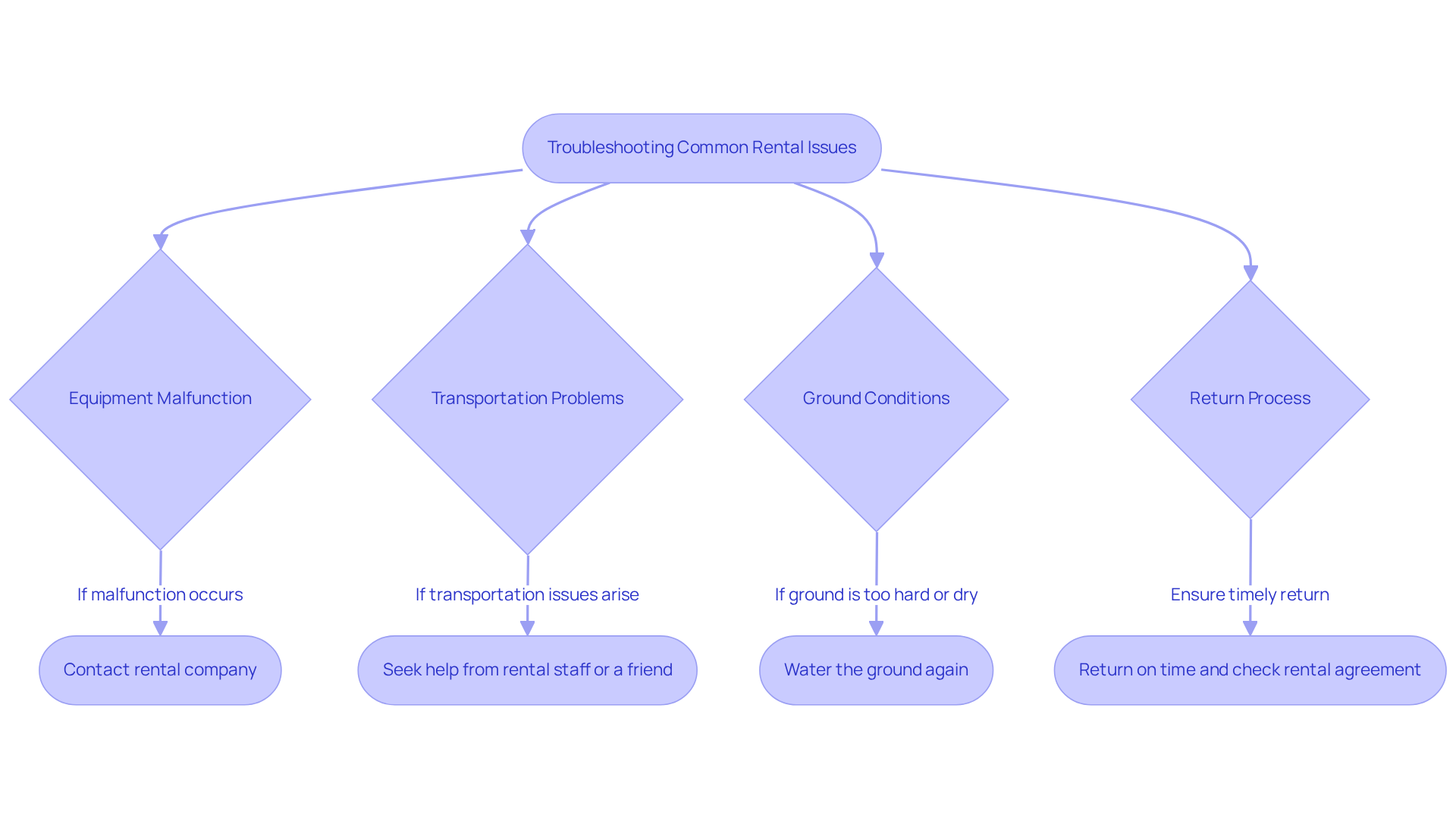Overview
To effectively rent a lawn aerator, it is essential to evaluate the size of your yard, conduct thorough research on rental locations, compare prices, reserve the equipment, and prepare for pickup. Additionally, one must consider the lawn's condition and perform an equipment inspection. This article elaborates on each step in detail, highlighting the significance of preparation and a clear understanding of rental agreements. Such diligence ensures a seamless aeration process, ultimately contributing to optimal lawn health.
Key Highlights:
- Lawn aeration involves perforating the ground to improve air, water, and nutrient access to grass roots.
- Key benefits of aeration include improved nutrient absorption, water drainage, thatch management, and stronger root development.
- Aeration is recommended every 1 to 5 years, depending on soil compaction and foot traffic.
- To rent a lawn aerator, assess yard size, research rental locations, compare prices, reserve equipment, and prepare for pickup.
- Key considerations before aeration include ensuring the lawn is moist, inspecting equipment, arranging transportation, and understanding the lease agreement.
- Common rental issues include equipment malfunction, transportation problems, hard ground conditions, and timely returns.
Introduction
Lawn aeration is an essential practice that can elevate a lackluster yard into a lush, vibrant landscape. Understanding the benefits of aeration—such as improved nutrient absorption and enhanced water drainage—enables homeowners to unlock the full potential of their grass. However, renting a lawn aerator can seem daunting, often leading to questions about equipment selection, rental locations, and preparation. What steps must one take to ensure a successful aeration experience while avoiding common pitfalls?
-
It is crucial to recognize the available services related to lawn aeration equipment. Various types of aerators are designed to meet different lawn needs, from manual models for smaller yards to powered options for larger spaces. By selecting the appropriate equipment, homeowners can significantly enhance the effectiveness of the aeration process. In addition, understanding the specific benefits of each tool can help homeowners make informed decisions that lead to healthier grass and a more attractive yard.
-
Preparation is key to a successful aeration experience. Homeowners should assess their lawn's condition and determine the best time for aeration, typically during the growing season when the grass can recover quickly. Additionally, ensuring that the lawn is mowed and free of debris will facilitate a smoother aeration process. By taking these preliminary steps, homeowners can avoid common pitfalls and achieve optimal results.
In conclusion, lawn aeration is a valuable practice that can transform outdoor spaces. By understanding the benefits of aeration and taking the necessary steps to prepare, homeowners can enhance their lawns significantly. Don't hesitate—take action today to unlock the full potential of your grass and enjoy a vibrant landscape.
Understand Lawn Aeration and Its Benefits
Lawn aeration is an essential procedure that involves perforating the ground to create holes, allowing air, water, and nutrients to effectively reach the grass roots. This practice is particularly crucial in areas subject to heavy foot traffic or compacted soil. The benefits of lawn aeration are manifold:
- Improved Nutrient Absorption: Aeration significantly enhances the ability of nutrients to penetrate the root zone, promoting healthier grass growth. Most grassy areas benefit from aeration every 1 to 5 years, ensuring optimal nutrient absorption.
- Improved Water Drainage: By alleviating ground compaction, aeration prevents water runoff and facilitates deeper water penetration, which is vital for maintaining moisture levels in the soil.
- Thatch Management: Aeration effectively breaks down thatch, a layer of dead grass and roots that can suffocate your turf. Eliminating thatch thicker than ½ inch is crucial for allowing sunlight, water, and nutrients to reach the ground.
- Stronger Root Development: With enhanced access to air and nutrients, grass roots can grow deeper and stronger, resulting in a more robust landscape. Compacted soil can cause grass roots to become malformed and grow shallow, making aeration a key aspect of yard maintenance.
As experts note, "It requires timing, the right equipment, and specialized knowledge to ensure the process is effective." Understanding these advantages underscores the importance of knowing where to rent a lawn aerator for efficient yard care, which ensures that your turf remains vibrant and healthy.

Follow the Steps to Rent a Lawn Aerator
To successfully rent a lawn aerator, follow these essential steps:
- Identify Your Requirements: Begin by evaluating the dimensions of your yard to determine the type of aeration device you need, whether a walk-behind or tow-behind variety. This initial assessment is crucial for ensuring you select the right equipment for your specific needs.
If you're looking for information, I can help you find where to rent a lawn aerator. - Research Equipment Locations: Explore local tool leasing companies to find out where to rent a lawn aerator, including . Visit their website or reach out directly to verify availability and discover their extensive selection of tools, which includes grass aerators, trailers, and forklifts, to suit your project.
- Check Rental Rates: Compare pricing for various rental durations—hourly, daily, or weekly—to secure the most cost-effective option. Typically, renting a lawn tool costs between $35 to $65 for a half-day and $65 to $100 for a full day. Remember, finding out where to rent a lawn aerator can save you time and money compared to purchasing equipment outright, making it a smart choice.
- Reserve Your Device: After selecting [EZ Equipment Rental](https://ezequipmentrental.com/about-us), make a reservation ahead of time to ensure you know where to rent a lawn aerator for your chosen date. Their store hours are Monday to Friday from 7:30 AM to 5:30 PM and Saturday from 7:30 AM to 5:00 PM, allowing for easy planning of your visit.
- Prepare for Pickup: Confirm the pickup time and location, ensuring you have suitable transportation to bring the aerator home. Keep in mind that aerating your yard can be accomplished in a timeframe comparable to mowing, so plan accordingly.
Furthermore, it's essential to consider the frequency of aeration based on your grass's ground type and traffic. For instance, grassy areas with compacted clay soil should be aerated each year, while those with low-traffic sandy soil might require aeration only every two to three years. As Stever Mercer, Manager of Northampton Rental Center, notes, "aerating your grass will go a bit faster than mowing," so plan your rental duration accordingly. For more insights and updates, follow EZ Equipment Rental on social media.

Prepare for Your Aerator Rental: Key Considerations
Before you pick up your lawn aerator, it’s essential to consider the following key factors:
- Lawn Condition: Ensure your lawn is adequately moist, yet not soggy. Water it a day or two before aeration to soften the soil, providing the best conditions for effective aeration.
- Equipment Inspection: Upon arrival at the leasing site, thoroughly examine the device for any signs of damage or deterioration. Confirm that it is in good working condition to avoid any issues during your aeration process.
- Transportation: Ensure you have a suitable vehicle to transport the aerator. If it’s too heavy or cumbersome, consider hiring a truck from the leasing company, and also check where to rent a lawn aerator to facilitate a smooth pickup.
- Lease Agreement: Read the lease agreement carefully, noting any charges for late returns or damages. It’s crucial to understand your responsibilities as a renter to avoid unexpected costs. By taking these steps, you can ensure a successful and hassle-free aeration experience.

Troubleshoot Common Rental Issues
If you encounter issues during your aerator rental, consider these essential troubleshooting tips:
- Equipment Malfunction: Should the aerator fail to function properly, cease use immediately and reach out to the rental company for assistance. This ensures safety and prevents further complications.
- Transportation Problems: If you experience difficulties loading or unloading the aerator, do not hesitate to seek help from or a friend. Ensuring safe transportation is crucial for effective operation.
- Ground Conditions: In cases where the ground is too hard or dry, it is advisable to water it again before attempting to aerate. Remember, aeration is most effective when the soil is moist, enhancing the overall results.
- Return Process: Lastly, ensure you return the aerator on time to avoid incurring additional fees. Always check the rental agreement for specific return instructions to facilitate a smooth process.

Conclusion
Lawn aeration is an essential practice that significantly enhances the health of your turf by enabling vital air, water, and nutrients to penetrate the soil effectively. Recognizing the importance of this process and knowing where to rent a lawn aerator can greatly contribute to maintaining a lush and vibrant lawn. By adhering to the outlined steps for renting an aerator, homeowners can ensure they have the right equipment to achieve optimal results in their yard care efforts.
Key insights throughout this article underscore the numerous benefits of aeration, including:
- Improved nutrient absorption
- Better water drainage
- Stronger root development
Furthermore, the step-by-step guide emphasizes the importance of:
- Selecting appropriate equipment
- Researching rental locations
- Checking rates
- Preparing for pickup
By addressing potential rental issues and preparation considerations, homeowners can approach the aeration process with both confidence and clarity.
Ultimately, investing time in proper lawn care, particularly regular aeration, enhances not only the aesthetic appeal of your landscape but also its overall health. The knowledge gained from this guide serves as a solid foundation for making informed decisions about lawn maintenance. Seize the opportunity to revitalize your lawn by taking action today—locate a rental location near you and provide your grass with the care it truly deserves.
Frequently Asked Questions
What is lawn aeration?
Lawn aeration is a procedure that involves perforating the ground to create holes, allowing air, water, and nutrients to effectively reach the grass roots.
Why is lawn aeration important?
Lawn aeration is particularly important in areas with heavy foot traffic or compacted soil, as it enhances nutrient absorption, improves water drainage, manages thatch, and promotes stronger root development.
How does lawn aeration improve nutrient absorption?
Aeration significantly enhances the ability of nutrients to penetrate the root zone, promoting healthier grass growth and ensuring optimal nutrient absorption.
What effect does aeration have on water drainage?
Aeration alleviates ground compaction, preventing water runoff and facilitating deeper water penetration, which is vital for maintaining moisture levels in the soil.
How does aeration help with thatch management?
Aeration effectively breaks down thatch, a layer of dead grass and roots that can suffocate turf, allowing sunlight, water, and nutrients to reach the ground more effectively.
What benefits does aeration provide for root development?
Aeration allows grass roots to access more air and nutrients, enabling them to grow deeper and stronger, resulting in a more robust landscape.
How often should lawns be aerated?
Most grassy areas benefit from aeration every 1 to 5 years to ensure optimal nutrient absorption and overall lawn health.
What considerations are there for effective lawn aeration?
Effective lawn aeration requires proper timing, the right equipment, and specialized knowledge to ensure the process is done correctly.




